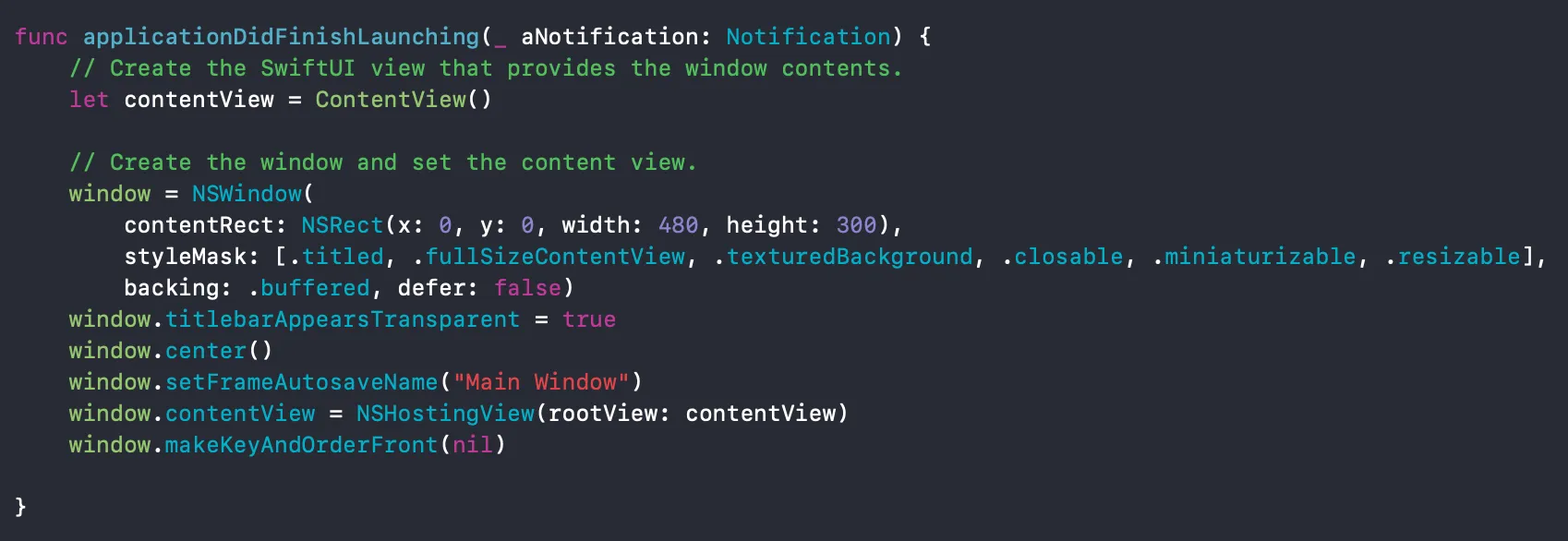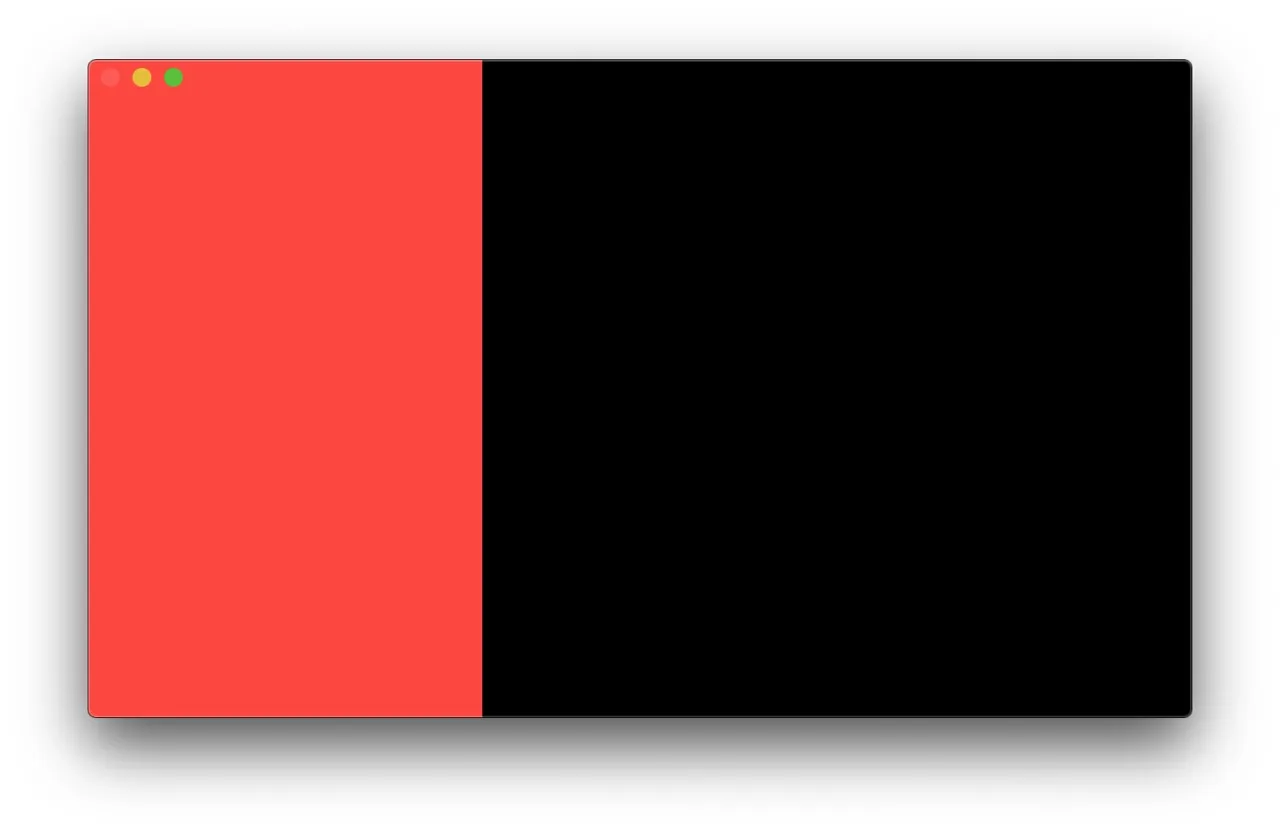NSWindow的内容视图不能覆盖整个窗口大小 - macOS和SwiftUI
15
- mhergon
2
它有什么问题吗?你想要一个没有标题栏的窗口吗? - Asperi
是的,我需要一个没有标题栏但带有关闭、最小化和调整大小按钮的窗口。两个视图(红色和黑色)必须延伸到标题栏和按钮下面。 - mhergon
4个回答
22
我刚刚在AppDelegate中使用了以下变体,ContentView和其他内容可以是任何内容。
func applicationDidFinishLaunching(_ aNotification: Notification) {
// Create the SwiftUI view that provides the window contents.
let contentView = ContentView()
.edgesIgnoringSafeArea(.top) // to extend entire content under titlebar
// Create the window and set the content view.
window = NSWindow(
contentRect: NSRect(x: 0, y: 0, width: 480, height: 300),
styleMask: [.titled, .closable, .miniaturizable, .texturedBackground, .resizable, .fullSizeContentView],
backing: .buffered, defer: false)
window.center()
window.setFrameAutosaveName("Main Window")
window.titlebarAppearsTransparent = true // as stated
window.titleVisibility = .hidden // no title - all in content
window.contentView = NSHostingView(rootView: contentView)
window.makeKeyAndOrderFront(nil)
}
- Asperi
5
指定
ContentView之外的边缘具有不同的效果,这很有趣。这可能是一个错误,或者SwiftUI的组合问题比我想象的更多。是时候进行更多实验了 :) 感谢您的回答! - ingoem2记录一下:如果我在
ContentView中有一个NavigationView,那么我仍然需要在NavigationView上使用edgesIgnoringSafeArea。 - ingoem1同时,我还添加了
window.isReleasedWhenClosed = false 来防止在关闭窗口时崩溃。 - johnny peter不幸的是,这似乎在macOS 12上无法工作。我无法使侧边栏占据整个窗口高度。 - Bryan
1@Bryan 我刚遇到了材料/视觉效果视图未覆盖整个窗口的问题。我猜你的侧边栏也是一个材料/视觉效果视图?在调试时,我注意到使用
Color可以正常工作,但是使用材料/视觉效果时,我必须使用.frame(minWidth: ,minHeight:)。 - iMaddin5
安全区域不包括透明标题栏下方。您可以使用
更新: 如果您想要使用NavigationView,您需要在其内容中添加"edgesIgnoringSafeArea":
很遗憾,当前这将最初显示标题栏,直到您强制进行全窗口重绘才会消失。一旦您将窗口移动到另一个显示器或隐藏并再次显示它,标题栏就会消失。所以,我的猜测是这个问题会在某个时候得到解决。
目前,您可以通过添加代码来强制执行隐藏和显示:
在
更新2:显然,如果您删除初始的
edgesIgnoringSafeArea命令,让您的内容视图忽略安全区域。以下代码类似于您的示例:struct ContentView: View {
var body: some View {
HStack(spacing: 0) {
Text("Hello, World!")
.frame(maxWidth: 200, maxHeight: .infinity)
.background(Color.red)
Text("Hello, World!")
.frame(maxWidth: .infinity, maxHeight: .infinity)
.background(Color.black)
}.edgesIgnoringSafeArea(.all)
}
}
更新: 如果您想要使用NavigationView,您需要在其内容中添加"edgesIgnoringSafeArea":
struct ContentView: View {
var body: some View {
NavigationView {
Text("Hello, World!")
.frame(maxWidth: 200, maxHeight: .infinity)
.background(Color.red)
.edgesIgnoringSafeArea(.all)
Text("Hello, World!")
.frame(maxWidth: .infinity, maxHeight: .infinity)
.background(Color.black)
.edgesIgnoringSafeArea(.all)
}.edgesIgnoringSafeArea(.all)
}
}
很遗憾,当前这将最初显示标题栏,直到您强制进行全窗口重绘才会消失。一旦您将窗口移动到另一个显示器或隐藏并再次显示它,标题栏就会消失。所以,我的猜测是这个问题会在某个时候得到解决。
目前,您可以通过添加代码来强制执行隐藏和显示:
DispatchQueue.main.async {
self.window.orderOut(nil)
self.window.makeKeyAndOrderFront(nil)
}
在
applicationDidFinishLaunching中使用window.makeKeyAndOrderFront(nil)后面接上,这将添加一个非常短的动画效果。如果您觉得它有点令人不舒服,可以通过NSWindow.animationBehavior或类似的方式关闭它。更新2:显然,如果您删除初始的
window.makeKeyAndOrderFront(nil)并将其替换为上面的调度队列逻辑,则不会出现动画效果。因此,最终您将拥有:func applicationDidFinishLaunching(_ aNotification: Notification) {
let contentView = ContentView()
window = NSWindow(
contentRect: NSRect(x: 0, y: 0, width: 480, height: 300),
styleMask: [.titled, .closable, .miniaturizable, .resizable, .fullSizeContentView, .texturedBackground],
backing: .buffered, defer: false)
window.titlebarAppearsTransparent = true
window.center()
window.setFrameAutosaveName("Main Window")
window.contentView = NSHostingView(rootView: contentView)
// window.makeKeyAndOrderFront(self) <- don't call it here
DispatchQueue.main.async {
self.window.orderOut(nil)
self.window.makeKeyAndOrderFront(nil)
}
}
- ingoem
5
正确的方法是使用NavigationView。在macOS中,您不应该使用HStack进行导航。它可以与您的解决方案正常工作,但无法与NavigationView一起使用。
我将保留此答案,等待其他选项。谢谢! - mhergon
你没有提到导航方面 :) 我已经更新了我的答案。 - ingoem
它为什么不够准确? - ingoem
很难评估。两个答案都是正确的,但另一个代码更少,更通用,适用于整个contentView等等。
我已经认真考虑了哪个答案是最好的。如果可以的话,我会给你们两个人分数。对不起... :( - mhergon
我可以想象,但我明白你想要建立声誉。 - mhergon
3
在 SwiftUI 应用程序生命周期方面提供更多信息。
您需要将窗口样式设置为 HiddenTitleBarWindowStyle:
WindowGroup {
ContentView()
}.windowStyle(HiddenTitleBarWindowStyle())
- Anthony
1
使用纯SwiftUI的最小解决方案。
@main
struct X_App: App {
var body: some Scene {
WindowGroup {
ContentView()
.edgesIgnoringSafeArea(.top)
}.windowStyle(.hiddenTitleBar)
}}
- arthas
网页内容由stack overflow 提供, 点击上面的可以查看英文原文,
原文链接
原文链接
- 相关问题
- 11 SwiftUI macOS NSWindow 实例
- 6 调整 NSWindow 内容大小以适应 SwiftUI 视图更新
- 5 拥有一个 fullSizeContentView 的 NSWindow,其大小与 SwiftUI 视图相同。
- 8 SwiftUI macOS命令(菜单栏)和视图
- 42 使用SwiftUI定义macOS窗口大小
- 29 macOS SwiftUI单视图导航
- 7 SwiftUI文档型MacOS应用程序的窗口大小
- 3 我的macOS应用使用SwiftUI编写,窗口(NSWindow)关闭后计时器仍然在运行。
- 7 基于NavigationView在SwiftUI的macOS应用中更改窗口大小
- 5 SwiftUI macOS 检测窗口关闭


